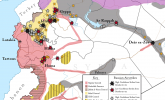 |
 |
Russian Airstrikes in Syria: September 30, 2015 - October 22, 2015
Key Takeaway: Russian airstrikes continue primarily to target rebel-held terrain in support of Syrian regime ground offensives in northwestern Syria. Russian airstrikes from October 19-20 largely supported regime ground offensives in rebel-held areas of the southern countryside of Aleppo and northern Hama Province far from core ISIS-held terrain. However, Russia continues to sustain its counter-ISIS narrative by claiming sporadic strikes against ISIS in Deir Ez-Zour and Raqqa Provinces. Russian Ministry of Defense (MoD) reported two strikes against ISIS in Deir ez-Zour Province from October 21-22. However, only one strike was verified through local reporting on October 21. Russian airstrikes reportedly hit a hospital in ar-Raqqah City on October 22. Local sources released pictures of damages to the hospital and surrounding buildings. However, the Russian MoD has not yet confirmed the strike, or any strikes from 1:00PM EST on October 22 and 3:30PM EST on October 23, claiming a technical problem with its website.
The Russian air campaign in Syria increases the Assad regime’s asymmetric capabilities against the Syrian opposition. Like the Assad regime, Russia is likely willing to inflict heavy civilian casualties in the process. Operation Inherent Resolve Spokesperson Col. Steve Warren reported the Russian use of cluster bombs in populated locations in Hama and Idlib Provinces, citing open source reports during a Department of Defense Press Briefing on October 21. Human Rights Watch released a report documenting the use of Russian cluster munitions on October 4, 2015 targeting the rebel-held village of Kafr Halab in northwestern Syria. However, Human Rights Watch could not determine whether the Russian-made munitions were dropped by Syrian or Russian aircraft. Pro-regime aircraft also used cluster munitions in Hama Province on October 11, according to local activist reports.
The following graphic depicts ISW’s assessment of Russian airstrike locations based on reports from local Syrian activist networks, Syrian state-run media, and statements by Russian and Western officials.
High-Confidence reporting. ISW places high confidence in reports corroborated both by official government statements reported through credible channels and documentation from rebel factions or activist networks on the ground in Syria deemed to be credible.
Low-Confidence reporting. ISW places low confidence in secondary sources that have not been confirmed or sources deemed likely to contain disinformation.
